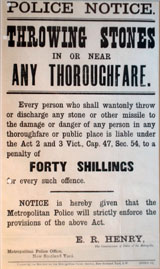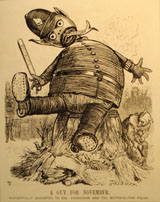Policing by Consent

Opposition from elements of the working classes deepened when a further Metropolitan Police Act was passed by parliament in 1839. There was little opposition from 'respectable' elements of society, as the act concerned regulating street behaviour. Indeed, the historian Stephen Inwood describes the act as: 'a charter for public order, cleanliness and decency, an imposition of respectable standards of behaviour on the streets of London'. Its wide powers could be used to cover vast areas of activity - trivial acts of misbehaviour, such as the throwing of stones for example.

Public concern about police behaviour invariably centred on the arbitrary exercise of power. This image from 1873 is particularly arresting. On 21 November 1873 PC White of the 'B' Division was charged with assault at Westminster Police Court. A Mrs Pither took refuge from her husband in an adjoining room of the house where they were resident. When Mrs Pither crept outside to see if her husband had fallen asleep, White stopped her. Instead of politely questioning Mrs Pither about her actions, White swore at her, pulled her off the pavement and hit her on the back. According to the magistrate, White charged her with loitering to prevent her from taking his number and reporting her. White was fined £4 and £1.9.0 [£1.45] costs.
It would be misleading to assume that the working classes as a whole were opposed to the police. Nevertheless it is difficult to assess how far they accepted the legitimacy of police power, or simply acquiesced in the face of its seeming omniesence. The working classes do not comprise a monolithic socio-economic group. They were fractured along lines of age, gender, race and ethnicity, as well as wealth, status and geography. Most crime was of a relatively trivial and petty nature, with property crime involving the theft of low value goods being the main problem. It is likely that those that suffered such crimes were of the working classes, and the fact that they reported their crimes to the police suggests a degree of legitimacy and a recognition that the police were there to help them too. The erosion of irregular street economies (such as selling from barrows that could be wheeled along the roads) during the twentieth century, following the standardization and formalization of work practices, reduced the number of workers in direct confrontation with police officers on the streets. Moreover, from the mid-1850s, with the exception of industrial and occasional political disputes, there were few significant disorders until the eruption of simmering tensions between peoples of West Indian extraction and the police exploded in Brixton in 1981.
The rioting in London in 1981 was partly brought about by resentment over what had become known as the 'Sus law'. This law was based upon sections of the 1824 Vagrancy Act. These sections authorised members of the old parochial police to stop, search and arrest anyone suspected of loitering, or otherwise intending to commit an offence. It was seen as a key element in the prevention of crime and its enforcement and was passed from the old police to the new. But the Sus law could also be viewed with suspicion as linked to arbitrary power, and as a memorandum of August 1935 demonstrates. It was recognized that for the activity to be effective, a greater number of innocent people would be stopped than potential thieves, and therefore its use needed handling with care, especially when complaints were made. Most of the people brought before the courts from the early nineteenth century were from the poorer sections of society hence, those suspected of being criminals tended to be from the poorer working-class. During the latter half of the twentieth century the assumption was often that young black males were the most criminal in the population. The Met accounted for 55% of the UK's 'sus' charges in 1976, yet London accounted for only 15% of the population. 42% of 'sus' arrests were made on black people, as opposed to 12% of all arrests. The 'sus' clauses were repealed in 1981.
 PC giving directions to a mono-cyclist, Hammersmith, c.1935.
PC giving directions to a mono-cyclist, Hammersmith, c.1935.